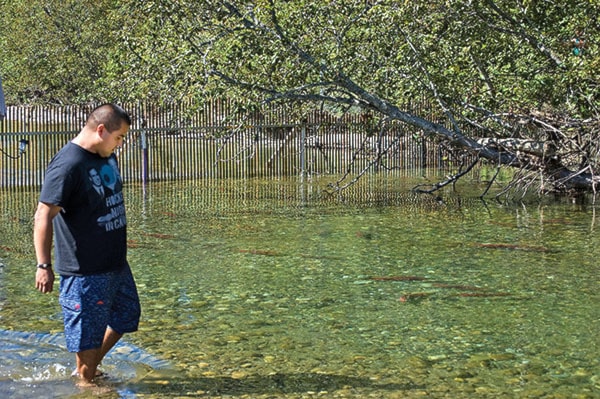There is joy amid the sense of gloom.
While concern continues about the state of the Adams River sockeye run, the sockeye that return to Scotch Creek have dramatically exceeded expectations.
Fisheries officials believed the run would amount to about 1,000 fish – or 1,800 at the most. As of Saturday, Aug. 31, 18,000 sockeye had come home to spawn.
Little Shuswap Indian Band fisheries co-ordinator Aaron Narcisse oversees operation of the fish fence on the creek. He says the band is grateful the run that begins in early August is so unexpectedly successful, considering the higher temperatures in the Fraser River.
The long, hot sunny days of summer may have been great for people, but not so good for many other salmon runs. Les Jantz, chief of the federal Department of Fisheries and Oceans (DFO)) BC Interior area, says the Scotch Creek run is indeed good news, particularly since the breed year in 2009 had 1,539 for the entire year,” said Jantz Friday.
As for the Adams River run, the one causing DFO concern, their story won’t be completed until November or December.
Some of the Adams River sockeye have changed their habits over the past few years, choosing to enter the Fraser River from the Pacific early.
“A number have entered early – they didn’t hold like they usually do for four to six weeks,” says Jantz. “probably some of those are in Shuswap lake as we speak.”
These fish will spawn at the same time as the sockeye just peppering to enter the river now, and prolonged periods in fresh water is hard for their bodies to handle he says.
In fresh water, the sockeye are being exposed to parviscapula, a parasite that causes malfunctioning of the kidneys. And the longer the fish are in fresh water, the longer the parasite grows, Jantz says.
“There’s probably some mortality this year,” he says, noting samples have been taken but not yet analyzed. “In a normal year, we will have some level, but when water temperatures are high and they come in early, the infection rate climbs.”
While it’s hard to estimate just how many there are, Jantz says there is some evidence that a number of late run sockeye are holding in the Gulf of Georgia.
“We’re still seeing some decent numbers of stock in Johnstone Strait,” he said. “The good news is the later fish will be exposed to much lower water temperatures (thanks to recent rains).”
The extremely high water temperatures were hard on early stocks, causing DFO to close salmon to fisheries in order to get as many fish up the Fraser River and into their spawning grounds as possible.
The picture is at least looking better than it did earlier. Estimations of the late run Fraser River sockeye were increased Thursday from 450,000 to 500,000 salmon.
